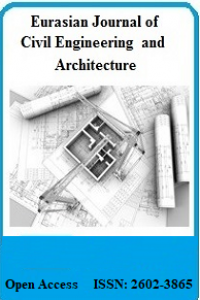COMPARISON BETWEEN ZERO SHEAR VISCOSITY AND STEADY SHEAR FLOW METHODS TO DETERMINE MIXING AND COMPACTION TEMPERATURES OF PMB
COMPARISON BETWEEN ZERO SHEAR VISCOSITY AND STEADY SHEAR FLOW METHODS TO DETERMINE MIXING AND COMPACTION TEMPERATURES OF PMB
Compaction, Mixing, Modified bitumen, Steady Shear Flow Zero Shear Viscosity,
___
- Hunter RN, Self A, Read J, Hobson E. (2015). The shell bitumen handbook, ICE Publishing, London, UK.
- Kanabar, N. (2010). Comparison of ethylene terpolymer, styrene butadiene, and polyphosphoric acid type modifiers for asphalt cement, MSC thesis, Queen’s University, Kingston, Ontario, Canada
- Khatri, M.A. (2005). Selection of Mixing and Compaction Temperatures for Hot Mix Asphalt Mixtures Produced with Modified Binders PhD thesis, University of Wisconsin, Madison, USA.
- Micaelo, R., Santos, A. and Duarte, C. (2012). “Mixing and compaction temperatures of asphalt mixtures with modified bitumen.” Proc., 5 th Eurasphalt & Eurobitume Congress, Istanbul, Turkey, Vol. 7, p. 7.
- Reinke, G. “Determination of Mixing and Compaction Temperature of PG Binders Using a Steady Shear Flow Test,” presentation made to the Superpave Binder Expert Task Group, https://engineering.purdue.edu/~spave/old/Technical%20Info/Meetings/Binder%20ETG%20Sept%2003%20Las%20Vegas,%20NV/Reinke_MIX%20AND%20COMPACTINO%20INFO%20FOR%20ETG%209-15-03.pdf. September 2003.
- Sengoz, B. and Isikyakar, G. (2008). Evaluation of the properties and microstructure of SBS and EVA polymer modified bitumen. Construction and Building Materials, 22(9), pp.1897-1905.
- Vachhani, K.K. and Mishra, C. (2014). Influence of VG30 grade bitumen with and without reactive ethylene terpolymer (Elvaloy® 4170) in short term aging. Int. J. Curr. Eng. Technol, 4, pp.4206-4209.
- West, R.C., Watson, D.E., Turner, P.A. and Casola, J.R. (2010). Mixing and compaction temperatures of asphalt binders in hot-mix asphalt (No. Project 9-39).
- Yildirim, Y., Solaimanian, M. and Kennedy, T.W. (2000). Mixing and compaction temperatures for hot mix asphalt concrete (No. Report No. 1250-5). University of Texas at Austin. Center for Transportation Research.
- Başlangıç: 2017
- Yayıncı: Serkan ŞAHİNKAYA
EXAMINING THE COMPONENTS OF GREEN BUILDING DESIGN AND ITS MANAGEMENT SYSTEM
Mohammad BEYKZADE, Sepide BEYKZADE
SURFACE FLOW, URBAN AND LAND-BASED POLLUTION LOADS IN DAVUTLAR BAY
Ayşe EDİNÇLİLER, Yasin Sait TOKSOY
EFFECT OF LIME ON UNCONFINED COMPRESSIVE STRENGTH OF A LOW PLASTICITY CLAYEY SOIL
Mustafa KARASAHİN, Erdinç KESKİN, İlker ŞAHİNOĞLU
INVESTIGATION OF FLUID-STRUCTURE INTERACTION BY USING SOLIDITY RATIO
Begum Yurdanur DAGLİ, Yesim TUSKAN, Dilay UNCU
